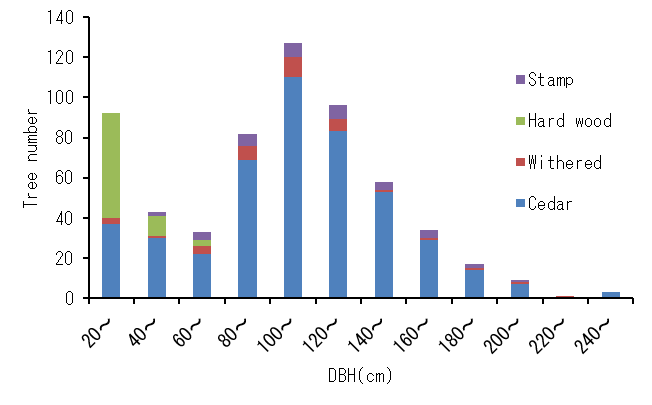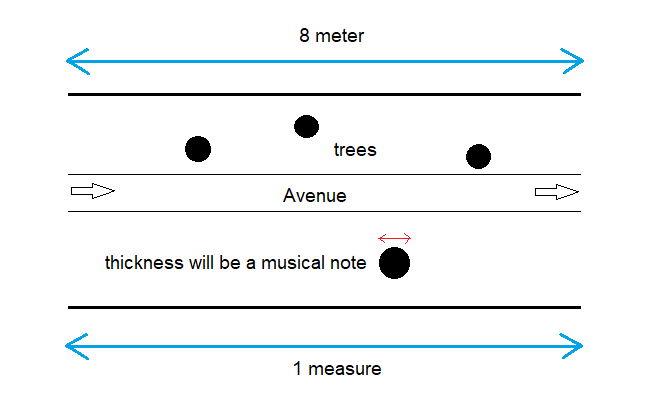| Sound of Forest | |||
| Rhapsody of the Cedar Avenue in the Mt. Haguro, Yamagata, Japan | |||
| Yoshihiro Nobori, 2019/3/12 | |||
| Introduction | |||
| Cedar avenue in the Mt. Haguro, the Dewa-Sanzan, Yamagata is a world famous landscape to the Michelin three star rank. Starting from the Zuishinmon gate as the length of 1700 meters on both sides of the 2446 stone steps are followed by 500-350 years old of Japanese cedar trees. More than 400 Japanese big cedar trees are provided in the natural monument in the country. The Five storied pagoda by the first slope marks as a national treasure, attracts many tourists from all over the world. Bowls, Gourds and Lotus flowers are carved in step stone. | |||
Zuisinmon gate |
 Five storied pagod |
 Cedar avenue |
|
| Health condition of the Cedar trees | |||
| Some big cedar trees have vertically cracked by strong wind, heavy snow and lightning, and the stems are fixed with iron bound rings. There is a hole, the central part of the stem rots. With thick trunk and bark looks ordinary, but it on the Crown almost not even there. Some have already dried up. Eventually, these old withered completely, will be destroyed. This approach to walk on a windy day is dangerous. | |||
| Measuring trees | |||
| Stand position, species, DBH(Diameter Breast Height), tree height, crown width and health condition of all trees within 5m of roadside were measured. The DBH range is from 20cm to 260cm and the highest number of DBH is 100 cm class as 130 tree number. It looks as normal distribution for the healthy cedar. In case of broad leaved tree, 20cm class of DBH is number of 50. Withered cedar trees are count about 10 % at thick DBH class. | |||
 Tree number of DBH class. |
|||
| Using the GPS position measurements can be reproduced in a GIS. Viewed in 3D on computer screens by the Forest Window. Figure shows 3D view of cedar row trees from the Zuishinmon gate to the hill top. We can observe the trees and that state is different. From the Zuishinmon gate to the Five storied pagoda, there are mixed big or small cedar and many broadleaf trees. It is prosperous image. | |||
 All trees of the avenue. |
|||
| After worship at the Five-storied pagoda, we can climb easy to the first slope. Many big cedar trees stand in lively. Some pain trees are stand in the second slope. As we climb in fatigue at the third slope, we cannot look for the cedar trees. Actually, there are many withered cedar trees. | |||
| Imagination | |||
| It issued a curiously on watching the computer screen with the crown projection. It becomes interesting music when walking down the stairs to the giant compared to the xylophone. It is that should be monotonous sounds is the Koff Koff continues as the notes of same size trees, and different pitch where the mix of big and small trees sound that King Kong Kang Kong. Then it should be so far are lined with cheerful sound, are there so many dead lonely sounds. This results in optimum forest health to learn about the reality of the cedar trees on the Mt. Haguro does not. So actually, cedar trees that were converted into musical notes. | |||
 |
|||
| Conversion to the Musical score | |||
| It is the same principle to convert Notes pitch as
the xylophone taps. Pitch frequency compared to exponential. Diameter classes
into logarithmically, and assigned to the pitch. Thick, big tree will sound low
and small trees will sound high. Diameter from 20 to 250cm was allocated to 2 octaves.
Note type is allocated that small trees have short notes, big tree have long notes.
There is no relation about notes and frequency. Diameter from 0 to 250 cm are
classified by equality as quarter note to sixteenth note. During the avenue, some buildings are important factors, so it were changed to the notes. Width of the building as lower than 3 m was fixed to mark quarter note, lower than 3.5 m was fixed to quarter note and quarter note, lower than 4 m was fixed to half note, lower than 10 m was fixed to whole note and quarter note, over than 10 m was fixed to whole note and mark quarter note. When distance of tree was long, rests note was fixed as the distance. Where there are lot of trees hits a lot of notes and few of trees hits a few of notes. It is important view point of healthiness of tree then timbres were adjusted. The instruments are selected by the healthiness. Then we can write the music score. Will it be what sounds like? |
|||
 |
 |
||
| Sound of the Cedar Avenue | |||
| Yamaha's XGworks ST MUSIC SEQUENCE SOFTWARE was used to write notes. When
we listen to the sound, very ornate and rich sound from the Zuishinmon
gate to the Five storied pagoda. Bass in March seems like the first slope.
Offers the second slopes in the bass sequence and in silence part and feel
very lonely. Slow base rhythm passes through on third slope in the muddy
sound and feel miserable. Trees compared to notes in the walk the avenue
lined with sound can be understood once we found. In the reality of the
avenue, appearance and sound was quite difference. We have to understand
that cannot sustain cedar trees and cedar trees on the Mt. Haguro at first
glance looks solemn, splendid the avenue reality is quite broken, will
not take action. Easy-to-understand, rather compared notes. Note that this
method is one example, and how to convert music notes should have infinitely
more. However, contains much of the logic. It is also might be something
such as research is often understood and have few means of indicating the
new direction of science and technology. It is Cedar Avenue location to
music composer Kamiyama Junichi has published sheet music collection is
the 'Mystic melody born 12 constellations-music of the stars", but
the same idea. It looks like the Columbus's egg. It is with the technique
shown here, all avenues in the world can replace the music. When I heard
the melody on the waking avenue, there are fine or and pathetic music.
As the trees will grow with the age, we must understand the change of the
sound of the avenue. It is irreversibly change nature. Walk through the
cedar avenue on Mt, Haguro with feeling the sound. By the way, assume you
can completely reverse thinking and techniques presented here. You can
replace wood notes indicated in the score. For example, you can replace
wood notes of Ayne Kleena Hatsik sheet by Mozart music on a avenue. It
must be a very fine Avenue. Emotion should produce as much trees as if
playing the melody. Over several years, is lined with trees each year is
directly proportional to the change notes. Music will evolve over the years.
It must be fine in thinking how change after 20 years. Table shown below is the music from the Rhapsody of the Cedar Avenue in the Mt. Haguro. |
|||